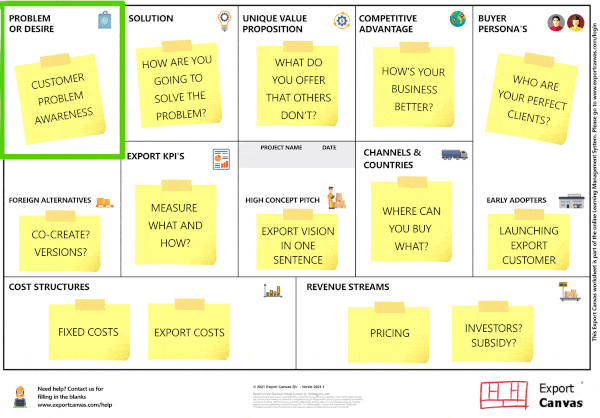
80
The profit is determined by your international value proposition
Develop a profitable export plan
Exporting to another country often entails unexpected costs. You will have to take this into account when you think about a profitable export plan. For example, do you use a forwarder or an agent? Or do you choose to open your own sales office.
On the revenue side, it is important to consider how you are going to market your product or service. Is the customer abroad the same customer as in the Netherlands? Does he have different wishes and requirements with the same expectations about your product? The advisor uses the export canvas to create such an export plan. You map out your international goals with 12 building blocks in 12 topics. Export goods, services of knowledge? Together with another advisor, you will think about your revenue model, the added value, customers, relations and suppliers.
Components of an Export Plan
What are the strong and weak points of your story? Do you want more revenue, or just better margins through a higher volume? Do you want to replace clients that you have lost during the crisis? Or do you want to grow in a specific market? Through the right questions and answers the Export Business Model Canvas will contribute to your goals.
- Step 1: Market Definition
The market definition determines the direction of your export. The market definition usually contains several dimensions: products, customer groups, and needs. In this step you look into the question of what the company considers as their market. - Step 2: Internal analysis
Is the company financially capable to broaden their market or develop their market? A financial ratio analysis is indispensable. Beside the financial approach you have to analyze both the organization as well as the product of the client. - Step 3: Export Country Selection
Which country would be the best to start selling your products? Focus on a few potential interesting export markets first, and then determine which ones you are going to tackle (first). - Step 4: Industry Analysis
The most important question for the exporter is how the developments in the industry of the chosen country will form. Then you will look at the opportunities and threats from the industry and how the export companies can position themselves within the markets. - Step 5: Competitive Analysis
In what way can the product differentiate itself from competitive products? Important is to determine who are the current or potential competitors and how they differentiate themselves. You design a competitive analysis based on how a competitive analysis can be defined. - Step 6: Customer Analysis
After, with the help of your filter model, you have chosen a few countries, you will determine which countries contain attractive segments that react homogeneous on the marketing policy. - Step 7: Distribution Analysis
An answer to the question on how the foreign market should be approached, an analysis of how the enter and their possibilities is necessary. You will put the pros and cons of the possible different channels opposite of each other. - Step 8: Confrontation Matrix
After the internal and external analysis you will put together a confrontation matrix. You will formulate a few options on how the country/market can be successfully realized. Also, you will set your growth strategy and determine your market choice and market entry strategy. - Step 9: Export Marketing Policy
Why should a foreign client buy this product or service and why should it be with you? In this part you will refine the P’s of the marketing mix. - Step 10: Financial feasibility of your Plan
In the last step you will ask yourself what is the extent of financial risks and what are the steps that need to be taken and what the feasibility of your plan.
The Export Canvas forms the basis for your Export Plan and further development of it.


Develop a profitable export plan
- Choose a location to sell.
It is critical to conduct research. With a bit of desk research, you can identify the markets. Find the consumption and import data for similar products, as well as the pace of economic growth in a potential new market. Investigate the demography, cultural and religious customs, and possible competitors. - Make a strategy.
Should include your people in your export strategy.
People who work for you
Is it possible for someone from your team to lead this program, or will you have to hire someone?
What is your capacity?
Do you have adequate capacity to handle the demands of a new market? Is it necessary to upgrade?
your product packaging
Will the style of your package appeal to your target market? Does the law require it to label items differently, or do you need to translate your labels?
Your Expertise
Pay a visit to your prospective new market. Showcase your items at trade shows and network with new people. - Decide on a marketing strategy.
One of four options is available to you.
1. Make a direct sale
2. Work with a distributor
3. Hire a salesperson.
4. Form a joint venture with another company.
Regardless of which choice you choose, you must clearly understand who is responsible for delivery and payment. In addition, you must ALWAYS remember to protect your intellectual property. - Look for opportunities.
One of the most acceptable ways to uncover possibilities in Canada is to attend trade shows. Meet potential clients and develop new business. Consult us about any funds to help defray the cost of showing, or see whether you can split the price of a booth with another company. - Begin marketing.
Advertisements can help you obtain exposure, but they can be costly. Keep in mind the target demographic and the cost vs. return on investment, just as you would in the Netherlands. Another alternative is to construct a website with material translated into your target market’s native language. Global social media platforms like Linkedin, Facebook, and Twitter can also assist you in quickly and cost-effectively promoting your message. - Be aware of the administrative procedures
Must complete specific administrative responsibilities correctly from the start. The Dutch Consulate and Embassy in Canada will assist you in understanding the customs registration, forms, and payment procedures.
Exporting is all about documentation; without it, there would be no contract, no transportation, and payment. The requirements differ from one country to the next. - Legal issues to consider
It’s critical to understand the legal and regulatory environments in all nations you want to export. We can assist you with completing your papers and putting you in touch with international lawyers if necessary.
Consider this: Are your product compliance certificates and liability insurance legal in other countries?
Examine your intellectual property rights and trademark registrations. - Logistics of transportation
You need to bring the products there now that you’ve made the sale and agreed on the terms! We can assist you in making sense of your transportation options. From your Incoterms insurance to tariffs and customs clearance to the packaging you need and the mode(s) of transportation or freight forwarders you need, we’ve got you covered.









